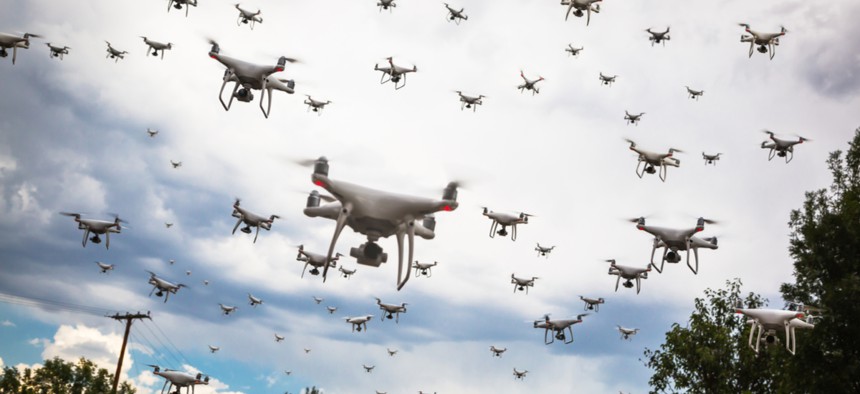Drone Swarms Are Going to Be Terrifying and Hard to Stop

Andy Dean Photography/Shutterstock.com
“Now the improvised explosive devices will find our warfighters."
As regular people purchase more drones, the small, unmanned aerial systems keep dropping in price and growing in capability. Once expensive, underpowered, remotely piloted toys with blink-of-an-eye battery life, consumer drones can now operate far more independently and for longer periods of time. They are nothing like the heavily armed fixed-wing drones such as the Reaper, which American forces have used to prosecute quiet wars across the world, but a new National Academy of Sciences report suggests that small, consumer-grade drones could be used in swarms to effectively attack American infantry with onboard bombs.
“Contrary to the past, when U.S. warfighters may have found improvised explosive devices, now the improvised explosive devices will find our warfighters," the report concludes.
While there have been occasional reports of souped-up consumer drones used in military conflicts, Russian military authorities said in January that a swarm of fixed-wing drones, which were made of plywood and loaded with explosives, attacked the country’s main air base in Syria.
“More than a dozen armed drones descended from an unknown location onto Russia’s vast Hmeimim air base in northwestern Latakia province, the headquarters of Russia’s military operations in Syria, and on the nearby Russian naval base at Tartus,” The Washington Post reported. “Russia said that it shot down seven of the 13 drones and used electronic countermeasures to safely bring down the other six.”
And these drones appeared substantially less sophisticated and maneuverable than a DJI Phantom 4, the leading consumer drone.
The National Academy notes that most of the counterstrategies that the Army has developed are “based on jamming radio frequency and GPS signals.” The thinking was: Drones needed those information flows to navigate effectively. Cut them off and you neutralize the attack. But, as more decision-making intelligence gets baked into groups of these systems, those techniques will become less effective. “Recently marketed sUASs [small unmanned aerial systems] have technological enhancements (e.g., obstacle avoidance and target-following technologies) that support autonomous flying with no need for a control link or access to GPS,” the report states.
And “kinetic” defenses—that means bullets and explosives—might also run into some problems with swarms of tiny aircraft. “Kinetic counters, such as shooting down a single, highly dynamic, fast-moving, low-flying hobby aircraft with small arms (rifles, shotguns, and light machine guns), are extremely difficult due to the agility and small size of sUASs,” the report states. “Additionally, swarming sUASs can be employed to overwhelm most existing kinetic countermeasures.”
These militarily attractive features are why the United States is working on massive drone swarms, too, and recent tests have included dropping more than 100 robin-sized Perdix drones out of two F/A-18 Super Hornets. The individual units then formed into a swarming formation, as seen below.
The report that was released to the public is an abbreviation of a much more extensive report available to military officials, but even the public’s glimpse of the analysis demonstrates that small drones could be an important component of war from now on.






